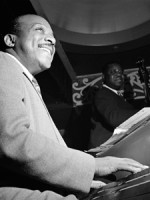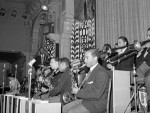Title
Subhead
When the Juilliard Jazz Orchestra takes the stage of the Peter Jay Sharp Theater on October 7, it will be performing music associated with one of the true masters of American jazz music, William “Count” Basie (1904-1984). Although proficient as both a pianist and arranger, it is mainly his legacy as the founder and leader of the Count Basie Orchestra, an institution that continues to the present day, that the Juilliard Jazz Orchestra will be celebrating in its concert, the first of its season.
Body
For Carl Allen, artistic director of the Juilliard Jazz program, the key to Count Basie’s music is its use of dynamics and tempo. “No big band played softer and slower than Basie’s,” he said in a recent interview. According to Allen, Basie believed that slow tempos would allow the band to gain the attention of the audience and allow listeners to really hear the melody. Allen wants the student musicians to understand the feeling of the music, because he believes that many of them haven’t grasped how important dynamics are. Count Basie himself once said, “If you play a tune and a person don’t tap their feet, don’t play the tune.”
Allen also believes that in addition to “meeting the students where they are” in terms of contemporary jazz (the Juilliard Jazz Orchestra concerts later in the year will feature the music of Juilliard alumnus Christian McBride and compositions by the musicians themselves), it is important for them to encounter the tradition and “learn to play with purpose.” He added, “Students must understand conceptually what the music is about and that each style of music is different.” In order to aid the musicians in this task, they will be mentored by three National Endowment for the Arts Jazz Masters who are alumni of the Count Basie Orchestra: saxophonist and flutist Frank Wess, trombonist Benny Powell, and trumpeter and Juilliard faculty member Joseph Wilder. The program for the concert will draw from some of the orchestra’s signature pieces and may include such Basie standards as “One O’Clock Jump,” “Jumpin’ at the Woodside,” “Splanky,” “Moten’s Swing,” “Lil’ Darlin,’” “Basie Straight Ahead,” “Shiny Stockings,” and “April in Paris.”
Although Count Basie is usually associated with the Kansas City jazz scene where he first gained fame in the 1930s, he was born in 1904 in Red Bank, N.J., where a performing arts center is now named for him. After playing piano for vaudeville, silent movies, and dances, in the mid-1920s he moved to Harlem, where he was mentored by two piano giants: Fats Waller and Willie “The Lion” Smith. Since touring was one of the ways a musician could support himself at that time, Basie toured both as a soloist and accompanist to blues singers. While on tour in Tulsa, Okla., in 1928, he heard and eventually joined Walter Page and his Blue Devils, an early big band that featured blues singer Jimmy Rushing, who later became a mainstay of Basie’s own band.
When Basie left Walter Page’s band to join Bennie Moten’s band in Kansas City, he became part of one of the legendary crucibles of jazz and blues. It was also at this time that he gained his title and became part of jazz royalty. According to Basie himself, he was playing at a club in Kansas City in 1936 one night and, since they were broadcasting, the announcer “called me to the microphone for those usual few words of introduction. He commented that Bill Basie was a rather ordinary name, and further that there were a couple of well-known bandleaders named Earl Hines and Duke Ellington. Then he said, ‘Bill, I think I’ll call you Count Basie from now on. Is that all right with you?’ I thought he was kidding, shrugged my shoulders and replied, ‘Okay.’”
After Moten died, in 1935, and the band was unable to continue, Basie formed his own band with many of the Moten alumni and the notable addition of saxophonist Lester Young. One of the innovations Basie made to the big band/jazz orchestra configuration was to feature two tenor saxophonists. His band was also known for its rhythm section (Jo Jones on drums, Walter Page on bass, and Freddie Green on guitar) and Basie’s spare, economic piano playing. With Jimmy Rushing as featured singer, the band was also famous for its blues repertory, accompanying such greats as Billie Holiday, Helen Humes, and Big Joe Turner. The tradition continued when Joe Williams became the featured vocalist in a later configuration of the ensemble.
When the Basie Band came to New York in 1937, it established itself as one of the major bands of the swing era. Not only did national tours follow, but while in Hollywood, the group was featured in several films. But not even this success could cushion Basie and his musicians against the economic problems facing large jazz ensembles after World War II, and he was forced to downsize to a sextet for a couple of years. But in 1952 he re-formed his unit as a 16-piece jazz orchestra that relied less on the improvisatory talents of the individual players, as the previous group had, and placed more emphasis on written arrangements by such talents as Neal Hefti (composer of “Lil’ Darlin”), Frank Foster (composer of “Shiny Stockings”), and 2009 Juilliard honorary doctorate recipient Quincy Jones.
Although Count Basie died in 1984, the Basie Orchestra has continued under several leaders and recently released a new CD, Swinging Singing Playing. The orchestra’s discography, encompassing more than 70 years of recording, includes live performances at the Newport Jazz Festival, numerous American and European venues, and a landmark session with the Duke Ellington Orchestra. The group has also recorded performances with many of the great American jazz and popular singers, including the vocalists who appeared regularly with the band and such artists as Ella Fitzgerald, Frank Sinatra, Sarah Vaughn, and Tony Bennett. Among the current members of the Count Basie Orchestra is Juilliard alumnus Marion Felder. For the Juilliard Jazz Orchestra, the October 7 concert represents an encounter with music from the past that continues to live not only in the performances of the Basie Orchestra itself, but in the repertory of jazz ensembles worldwide.






